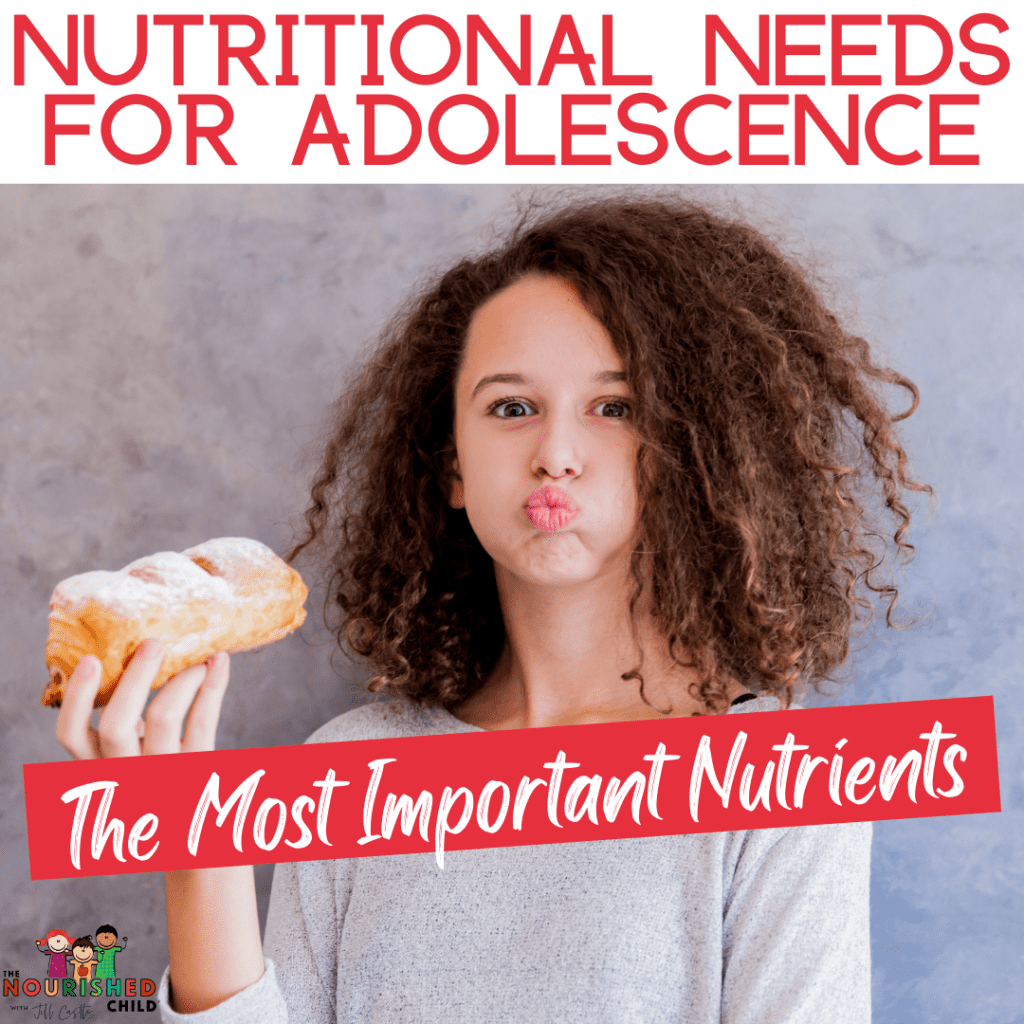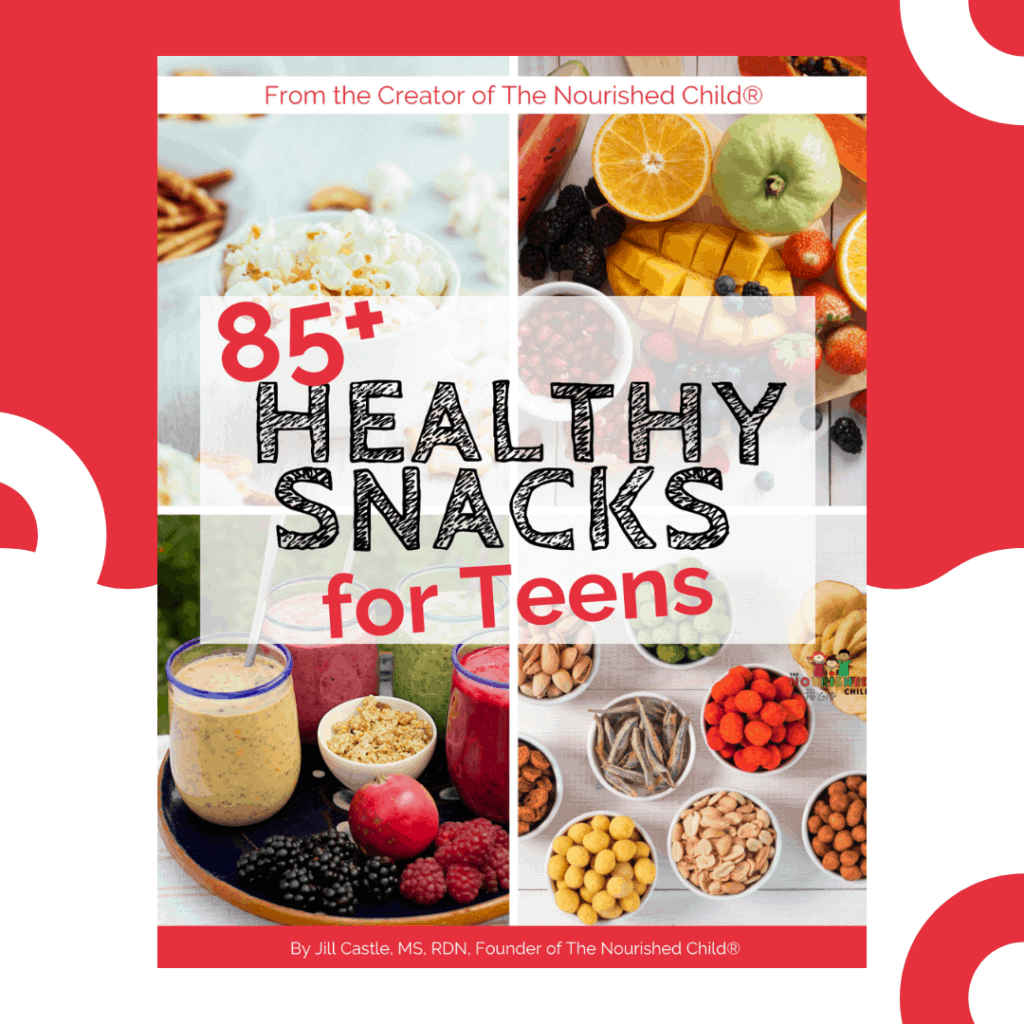Nutritional Needs for Adolescence: Important Nutrients and More
March 25, 2022
There are many important nutrients for teenager growth and development during puberty, but a few critical nutrients stand out. So let’s dive into these key nutritional needs for adolescence.
Did you know that the gap between dietary recommendations and what is actually eaten is the greatest during the teenage years?
Appetites soar, girls enter menarche and lean muscle mass increases in boys. Adolescence is not only a time of bodily transformation, but dietary habits also change as children grow older. According to the Dietary Guidelines for Americans, teenagers eat half the recommended amount of fruits and vegetables by the time they enter late adolescence.

Kids require a balanced diet with enough calories and key nutrients for growth and healthy development, especially during adolescence when nutritional needs rise to meet the needs of a major growth spurt and puberty.
So let’s dive into the energy and nutritional requirements of adolescence.
How Many Calories Should a Teenager Eat?
Teenagers experience major growth spurts as they go through puberty and approach full maturity.
During adolescence, boys have an increase in muscle mass. The increase in muscle means they need more energy (calories) to fuel their faster metabolism. A growth spurt in boys usually happens between 9 and 14 years old, later than girls.
Girls need fewer calories than boys because they have less muscle mass and girls stop growing and reach full maturity earlier.
Moderately active teenage boys need between 2,200 and 2,800 calories a day, according to the DGA, and moderately active teenage girls need approximately 2,000 calories a day.
Of course, there’s a nuance here. Energy requirements vary depending on activity level, gender and weight. For example, boys who are more active may need more calories than less active boys. The same is true for girls.
To fuel big appetites during growth spurts, allow teens to eat when they’re hungry, encourage them to consider their hunger signals and feelings of fullness, and eat a nutrient-rich diet most of the time.
Keep easy snacks around the house for teens to grab when hungry. Healthy snacks are one way to make sure teens get a variety of nutrients and enough energy to stay healthy.
Let’s look at the key nutrients necessary for adolescent growth and development.
How Many Carbohydrates Do Teens Need?
The body and the brain use carbohydrates for energy. Teens require at least 130 g of carbohydrate per day, and likely more, or about 45 – 65% of their total energy intake.
Whole grains, vegetables, fruits and dairy products are good, nutrient-rich sources of carbohydrates.
Active teens and athletes typically need more fuel from carbs to keep their energy levels up.
How Much Protein Should a Teenager Eat?
Protein plays a major role in muscle development and repair.
During puberty, boys and girls gain weight as they shoot up and develop. In addition, boys put on a significant amount of lean muscle mass so their protein needs are higher than girls.
Teenage girls need about 1/2 gram of protein per pound of body weight each day. The same goes for boys. Going overboard on protein isn’t helpful, because the body takes the excess and changes it to energy, in most cases fat.
Meat, poultry, fish, eggs, milk and cheese are well-known protein sources. However, many animal proteins are also high in saturated fats.
Choose lean cuts of meat to cut down on saturated fats. Nuts, legumes, beans and soybeans are also excellent sources of plant-based proteins.
How Much Fat is Healthy for Teens?
The body and brain need fat to function optimally.
And vitamins A, D, E, and K are fat-soluble vitamins that need dietary fat to be absorbed by the body.
The recommendation for teen boys and girls is to keep their fat intake between 25 – 35% of total daily calories.
Ideally teens should limit saturated fat and trans-fat, which increase “bad” cholesterol and causes a build-up in the arteries.
Omega-3 fats fight inflammation and support healthy brain development.
Flax seeds, chia seeds, salmon, walnuts, and canola oil are sources of omega-3.
Three Important Nutrients for Teenagers
Calcium, iron, and vitamin D are essential for strong bones, muscle growth and optimal cognitive development during peak periods of growth in teens and are considered some of the most important nutritional needs of adolescence.
Iron
The requirements for teenage boys and girls increase during adolescence, especially for young athletes.
Girls have higher iron needs in menarche and iron requirements remain high as girls grow into adulthood. Boys have higher iron needs as they develop lean body mass. When boys reach adulthood, their iron requirement drops back down to pre-adolescent levels.
Iron requirements are even higher during adolescent growth spurts.
Recommended Dietary Allowances (RDAs) are the average daily intake required to meet the nutrient requirements for most healthy people.
The iron RDA for boys is:
- 9-13 years:: 8 mg/daily
- 14-18 years: 11 mg/daily
The iron RDA for girls is:
- 9-13 years: 8 mg/daily
- 14-18 years: 15 mg/daily
Iron is found in various foods, and most kids can get the iron they need from a healthy and balanced diet.
Some of the best sources of iron include:
- Lean meats and seafood
- Fortified cereals and grains
- Lentils
- Nuts
- Beans
- Raisins
- Tofu
- Whole wheat spaghetti
- Eggs
- Spinach
- Broccoli
Calcium
Adolescence is a critical time for bone growth, so it’s no surprise that calcium requirements are highest during puberty.
For 9-18 years, the calcium RDA is 1,300 mg per day.
Dairy such as milk, yogurt and cheese are the richest sources of calcium, but many non-dairy foods contain calcium too.
Calcium-rich food includes:
- Yogurt
- Cheese
- Milk
- Orange juice fortified with calcium
- Tofu made with calcium sulfate
- Soybeans
- Canned salmon
- Fortified breakfast cereals
- Kale, spinach, turnips, Bok choy, and broccoli
- Beans
- Chia seeds
*Cow’s milk alternatives don’t have the same nutrients as cow’s milk. So, teenagers who avoid dairy because of milk allergies or follow a vegan diet need to take extra care to include more calcium from other sources.
Vitamin D
Both calcium and vitamin D are required for bone health and growth.
While vitamin D requirements are the same for teens and adults, absorption is enhanced during puberty to support significant bone growth.
For 9-18 years, the vitamin D RDA is 15 mcg (600 IU) per day.
Vitamin D is a hormone that’s activated in the body with the help of sunlight. So the best way for teens to get vitamin D is by doing activities outside!
Vitamin D deficiency is not uncommon, and teens may need to take a vitamin D supplement.
Most foods that contain vitamin D are fortified. Here are some of the best sources of this important nutrient for teenagers.
- Trout, salmon, tuna, and mackerel
- Mushrooms
- Eggs
- Fortified milk
- Fortified soy, oat and almond milk
- Fortified cereals
- Cheddar cheese
- Mushrooms

Download
85+ Healthy Snacks for Teens!
Final Thoughts About the Nutritional Needs for Adolescence
A balanced diet with adequate carbohydrates, protein, plant fats, vitamins, and minerals is essential for a teenager’s growing body and brain.
Teens are always on the go and eating out with friends. This can make it tough to make sure they get all the nutrients they need. But with a little planning, it is definitely possible. The good news is there are plenty of nutritious foods and snacks teens can enjoy.
Your teen’s growing appetite should be encouraged, but a variety of foods and a balanced diet are still important.
Are you concerned that your teen isn’t getting enough of the right nutrients?
Check out some of our nutrition classes and guidebooks designed to help you nourish your child, inside and out.
You may enjoy:
Delayed Puberty: Should You Worry about the Late Bloomer?










